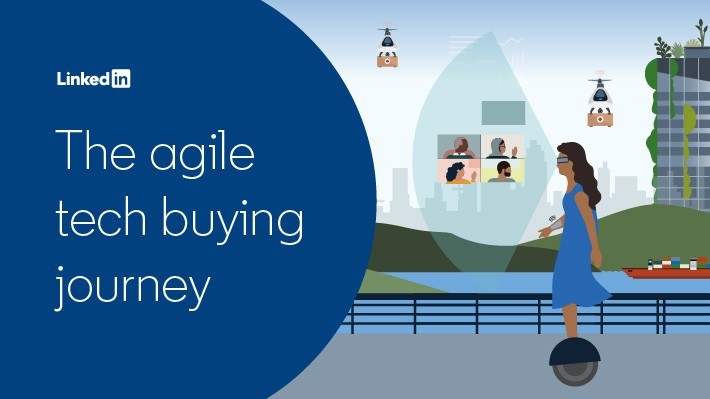Flexing to the new agile buying journey
Mapping the technology buyer journey used to be relatively simple. Your buyers were IT decision-makers, with only had a handful of big vendors to choose from. Sales teams knew where to find their targets - whether at events, through cold calls, or incoming enquiries. Sales meetings were standard practice, to understand customer needs and build relationships. The process was largely linear and predictable, enabling marketing and sales to plan their approaches accordingly.
But how things have changed. The proliferation of technology solutions, along with the digitisation of the entire marketing mix, have transformed the tech buying journey, making it more complex and varied than ever. The LinkedIn Technology Buyers Report, a survey of 2,000+ tech buyers across Europe, the Middle East and Africa, found that nearly half of enterprise buyers take over a year to purchase technology, but that many move much quicker, with around a quarter taking six months or less.
Marketers have to contend with more buyers and influencers than in the past, ranging from marketing and sales, to finance, procurement and beyond. Each stage of the journey has become more drawn out with less defined stop/starts, meaning new contacts drop in and out throughout the process. Nowadays, B2B tech buyers are in control, and marketers have to be both hyper informed and agile to influence their decisions.
Here’s what you need to know about each stage of the modern B2B tech buyer journey:
Evaluate: making a connection
Technology buyers take around three months on average to evaluate their requirements, involving two interconnected tasks: identifying the problem, then researching and zoning in on potential solutions. This stage incorporates the largest number of buyers (55%), with each person bringing different needs and perspectives to the table. This can mean a lot of back and forth, as the committee works through these different priorities and starts to develop a hierarchy of needs.
“An opportunity will have twice as many stakeholders involved today compared to a few years ago,” says Sébastien Imbert, CMO, Microsoft France. “The Chief Environment Officer is often one of the roles involved, and we’re having conversations with Chief Technology Officers, Chief Financial Officers and Chief Marketing Officers as well.”
At this stage, buyers are all on their own fact-finding missions – either passively or actively - looking for information to help them understand the problem they’re facing and to narrow down their search. They are probably not ready to talk to you yet – many are still anonymous buyers - and they have vast quantities of information at their disposal, spanning research reports, online guides, videos, social media comments, peer reviews, and more.
The key for marketers is to draw on customer data to make their own content as relevant and helpful as possible, pushing the right buttons at the right moment, for different audiences. It is about quality, rather than quantity, tapping into customer needs, concerns and interests, while using your sector experts and customer advocates to bring your brand story to life.
Shortlist and buy: knowing your audience
It’s decision time, when buyers draw on all of that research to narrow down their search to a shortlist of two or three. Well, that’s the theory! The technology buyers survey found that this stage takes around two months on average, and the proportion of buyers involved decreases, but only very slightly, to 50%. Reaching a consensus can be tricky, and again, buyers are likely to circle back on previous stages, as the buying committee reevaluates its requirements and the options available.
This is the point at which buyers will start to dig more into the specifics of your solution, for example comparing and contrasting exact product features, analysing prices, along with how subscriptions and licensing models work. Current economic concerns mean that price is currently the top consideration (73%) for buyers, followed by product features (67%). However, marketers must factor in a range of priorities, for example IT may want to know about data security, while end-users may have more questions about post-sales support.
Buyers might make contact at this stage, or they might choose to continue with their own self-directed research, so ensure information is easily accessible online, or better still, offer customers the option of a free trial or online demonstration. When buyers do reach out, expect them to be well informed about what you and your competitors offer. Sales and marketing must be work together to ensure salespeople are armed with as much data as possible, to have meaningful conversations.
Implementation and post-sales: Living up to your promises
Implementation is the second longest phase of the buying journey, taking almost four months - or over five for enterprise buyers. More than two fifths (43%) of the buying committee are involved, so maintaining key relationships is critical. There are lots of moving parts, and everybody wants to see value as quickly as possible. Rather than stepping back, marketing must ensure that the reality lives up to the promises, giving buyers everything they need to maximise the solution and meet their objectives.
“We've adopted a mantra of ‘Attract, Transact, Interact,” says Hans A.T. Dekkers, Chief Digital Officer & VP Digital Sales EMEA, IBM. “You attract clients. You transact with them. And once you transact, you keep interacting, helping them do more with technology.”
Renewal: The proof is in the results
Perhaps surprisingly, renewal is the longest part of the buying journey, at over six months on average. But renewal isn’t a standalone event - it’s the result of how you have nurtured relationships with each of your customers since they first came onboard, and even before.
Have your products and services lived up to your marketing promises? Have you delivered the value expected, in the timescale outlined? And have you become a strategic partner, by continuously looking to add value across the business? If the answer is ‘yes’, then customers will have no reason to look elsewhere. If not, then it’s time to reflect on what was missing.
It’s all about the experience
We talk about the ‘average’ tech buying journey, but there really is no such thing as ‘average’. Each organisation follows its own unique path to a decision. But that doesn’t mean that mapping these journeys isn’t important, it just means focusing at a more granular level, maximizing data to understand what matters to different audiences at key moments, and building a picture of the whole customer experience. Doing this enables you to see where the gaps are and identify the opportunities to make a difference. And that is the surefire way to winning customers who stick around, for renewal and beyond.
“As sales and marketing, I really recommend that you focus on the experience that you want to provide – not just the marketing material or the brand campaign but the full buying cycle,” concludes Dekkers. “What you’ll find will be remarkable, and then once you understand what the client goes through, you can start to ask what actually works in this digital world we’re now operating in.”
The LinkedIn B2B Technology Buying Survey – Age of Agility EMEA Report 20/ 21 lays out the five key trends in a new and dynamic landscape for technology marketers. Discover what your buyers need from you today.
Related articles



